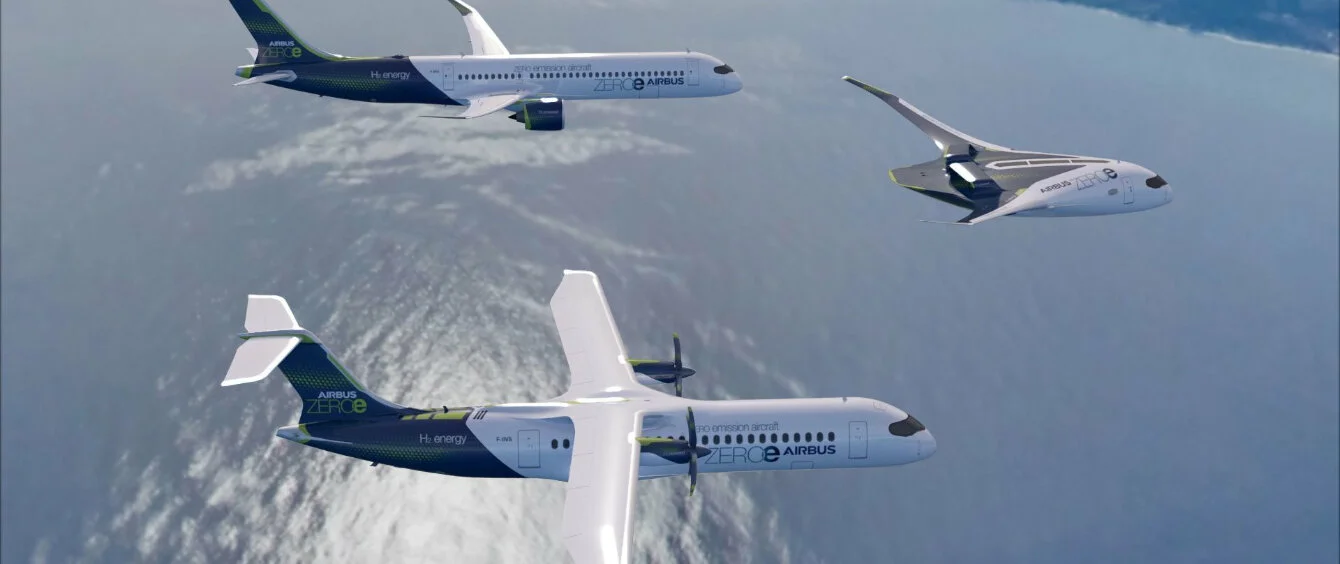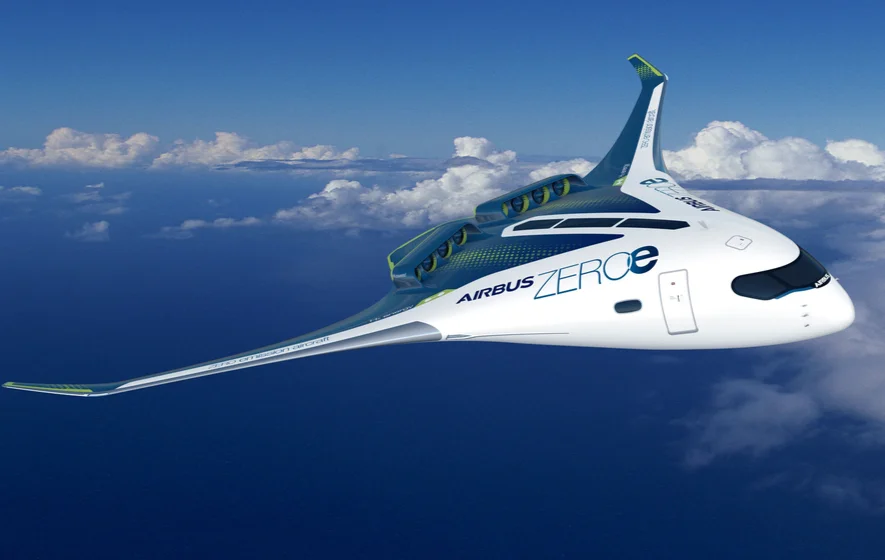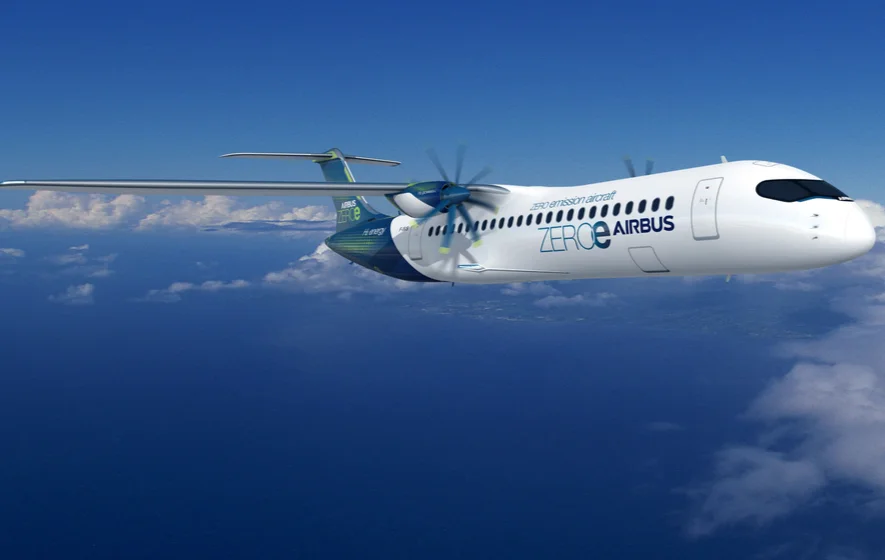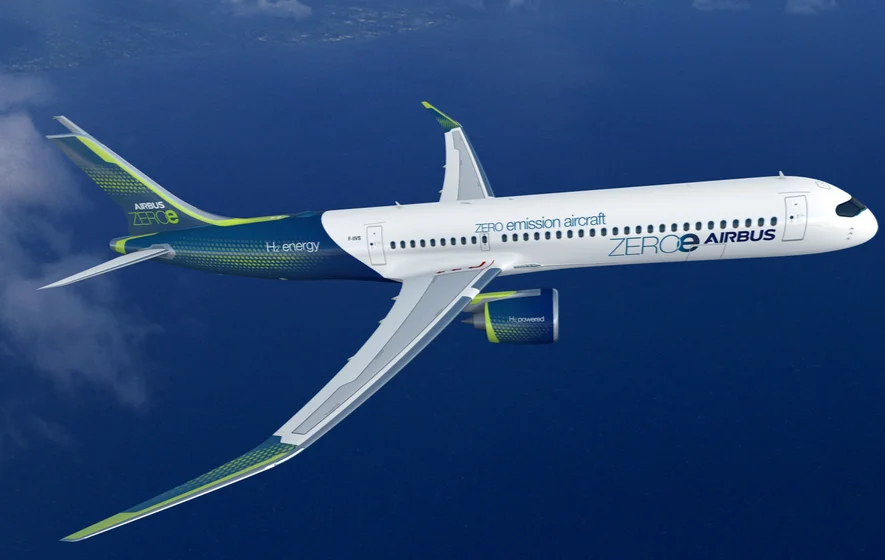The first commercial passenger aircraft fuelled entirely with hydrogen is set to take to the skies in 2035 – at least this is the vision articulated by European aircraft manufacturer Airbus. Under the code name ZEROe – short for zero emissions – CEO Guillaume Faury recently presented a total of three concepts. These are designs for various zero-carbon airplanes envisaged for scheduled flights. The aviation group aims to set the stage for the decarbonisation of air travel using one of the three concepts in the years ahead.
Range of up to 3,700 kilometres
With its ZEROe plans, the world’s largest aircraft manufacturer is taking a major step forward. “This is a historic moment for the commercial aviation sector as a whole and we intend to play a leading role in the most important transition this industry has ever seen,” Airbus chief Guillaume Faury announced. The concept has involved the company teaming up with airplane engine builder Safran, a joint venture of the Ariane Group and French aviation research centre Onera.
This is what the Airbus hydrogen aircrafts should look like
The result is three designs, with the first airplane to be fitted with a modified gas-turbine engine. Its shape is similar to that of modern passenger aircraft. The hydrogen tanks would be located in the rear. The jet should be able to transport 120 to 200 passengers about 3,700 kilometres. By comparison, an Airbus A320 has a range of 5,500 kilometres. The second option is a turboprop design, also fuelled with hydrogen, and capable of flying up to 100 people over 1,000 kilometres. The most futuristic is the third entry, reminiscent of a ‘blended wing body,’ a concept in which the wings merge with the plane’s main body, making it look like a giant wing. It would accommodate 200 passengers and have a range of 3,700 kilometres.
Funding from the corona aid programme
Development will benefit from the French government’s 15 billion euro aid programme for the aviation sector during the corona crisis. One of the conditions is that the transition to hydrogen propulsion be initiated by 2035. France’s national hydrogen strategy has also earmarked several billions of euros for technology research and the expansion of the hydrogen economy.
The 15-year roadmap established for the undertaking is quite ambitious. After all, simply equipping existing aircraft with hydrogen tanks, a fuel cell or modified turbines won’t cut it. This is because, pound for pound, liquid hydrogen occupies four times more space than kerosene. Furthermore, it has to be cooled to minus 253 degrees Centigrade and compressed significantly. Hydrogen-powered airplanes must thus be newly designed from the ground up – with tons of room for the special tanks.
However, switching to new, more climate-friendly propulsion technologies is a task that must be fulfilled by the entire sector. According to the International Energy Agency (IEA) aviation is responsible for 2.8 percent of global carbon dioxide emissions from fossil fuel. To achieve the Paris climate goals, aircraft manufacturers, airlines and airports must all play their part. They must develop novel, lower-emissions models and technologies, modernise their fleets and set up the infrastructure required to implement the transport transition in the skies.
Several hydrogen applications
The German Aerospace Centre (DLR) believes that Power-to-X technologies will play a key role. After all, hydrogen can be used to power airplanes in myriad ways. The fuel can be burned directly in modified gas turbines. Fuel cells can convert hydrogen to electric energy to drive electric motors. And, when combined with carbon dioxide, hydrogen can be used to produce synthetic kerosene.
As an aside, the notion isn’t entirely new: Back in the 1980s, the soviet Union converted a Topulev passenger airplane to run on hydrogen. The government wanted to reduce its dependence on petroleum after the oil crisis. Although the aircraft completed numerous test flights successfully, the project was discontinued.
Renewable fuel quota in the works
As the energy transition progresses, the European Union is increasing pressure to bring the required technologies to market. The objective is to have renewable energy account for 14 percent of all fuels used in the transportation sector. This compares to a mere eight percent in 2019.
The German government also plans to introduce a renewables quota for kerosene. The current bill submitted by Environment Minister Svenja Schulze calls for 0.5 percent of the aviation fuel being based on hydrogen and produced using renewable energy by 2026, with this share rising to one percent in 2028 and two percent in 2030.
The daft law further envisages the fuels being of ‘non-biogenic’ origin. Therefore, biokerosene, which is obtained from crops like biofuels, and has already been tested by such players as Lufthansa, may not be used to achieve the above quota. Alternative fuels had not yet been assigned fixed quotas when the national hydrogen strategy was adopted early in the summer of 2020, instead just being a subject of exploration.
Electric drives with startup problems
Another technology is still teething. Although it is already technically possible to build airplanes with electric drives, manufacturers in aviation are facing bigger problems than their automobile counterparts. To date, prototypes have a very small range, and the batteries are extremely heavy. Since every gram holds back take-off, electric aircraft are far from being feasible.
So approaches to spurring the energy transition in aviation do exist. Moreover, this undertaking enjoys the political support of national hydrogen strategies like the ones presented in Germany and, more recently, in France. Guillaume Faury is optimistic: ” Together we can rise up to this challenge to scale-up renewable energy and hydrogen for the sustainable future of the aviation industry.”
Photo credit: ©Airbus 2020



